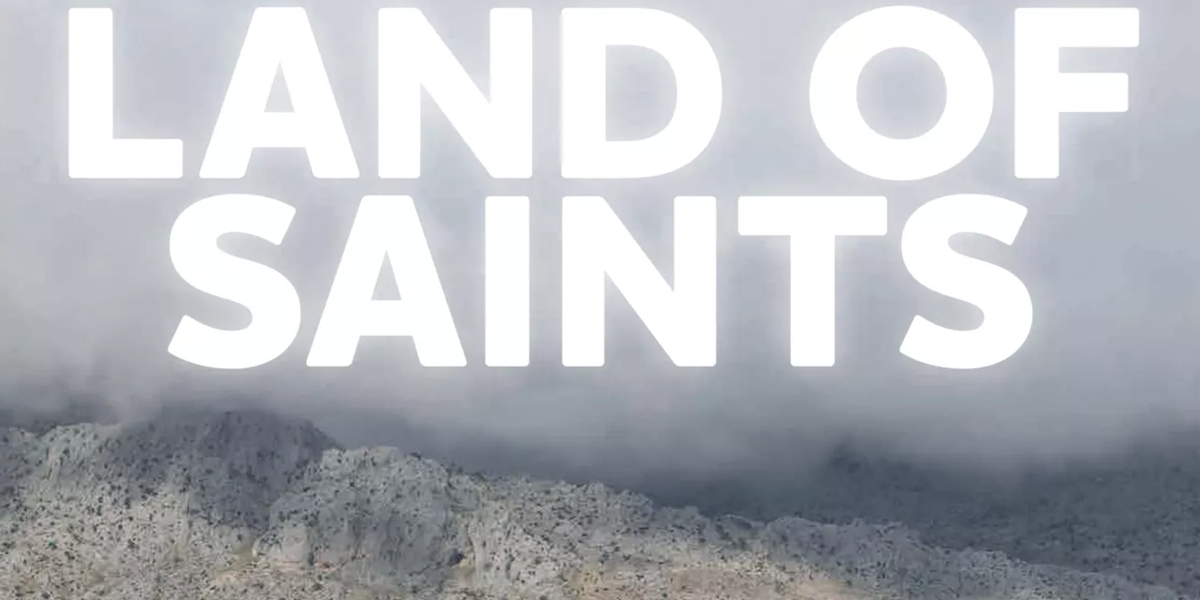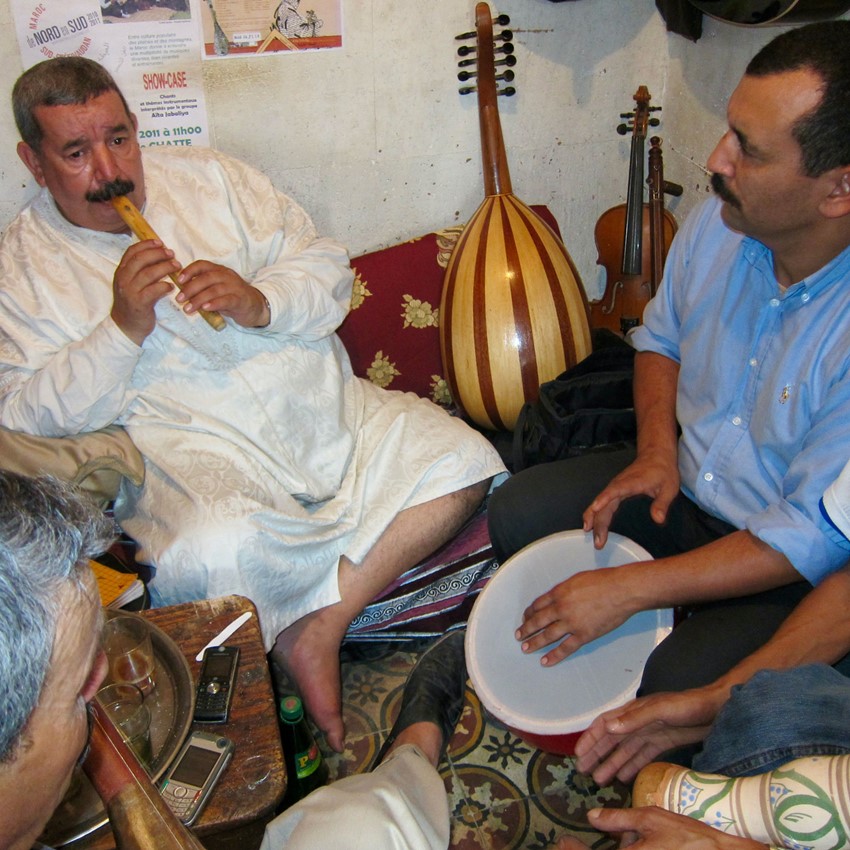Monday, August 8, 2022
A guide to the music of Morocco's Jebala mountains
The Jebala mountains of northern Morocco are the source of many musical riches, with plenty of beguiling artists there to be discovered

Thousands of pilgrims gather on a mountain top in the heat of July. The mountain, called Jabal Alam, is located on land belonging to the Bani Arous tribe and is around 100km south-east of Tangier.
The focus of attention is the simple grave of Moulay Abdeslam Ben Mchich (1140-1227), who is considered the towering Sufi saint of the western part of the Islamic world.
See also: Master Musicians of Jajouka - A Beginner's Guide
Everywhere you notice hardworking women wearing hats of straw and colourful shawls of wool, their faces dark from field work. The men are mostly wearing white-hooded djellabas and the yellow slippers that are standard dress for religious celebrations.
Reaching the top of the mountain you seek out the saint. A solitary path leads up to the top, where you must leave your shoes in a pile and step on flat pieces of cork hammered into the rocky surface.
To the right is a small mosque with a low minaret and to the left is a square made of logs from an olive tree. You find your place and contemplate a low wall with a square hole with rusty bars behind which an olive tree grows. Here lies the remains of the holy man.
To your right a group of male Quranic singers with angelic voices chant and behind you is a sheer drop of several hundred metres. Locals in the Jebala region describe a visit to Moulay Abdesalam as the poor man’s hajj.
After paying respect at the shrine, the traditional Moroccan fair gets going and continues all night in tents down the side of the mountain.
music of Jebala
Here the complex rhythms and piercing sound of the ghaita (oboe) dominates and you are invited into the tents that belong to various villages, tribes or Sufi groups with musicians who seem to be able to play anything you need.
It can be wedding music, ancient poetry or spiritual trance. Just whisper into the ear of the man in white called the moqadem (manager), pay a sum of money and be instantly transported by flutes, ghaitas or violins soaring and counter rhythms that take you over the edge.
It is like being filled up at a gas station with divine fuel of every octane.
This area of northern Morocco is called the Jebala, and its music – characterised by ghaita, kamanja (fiddles), complex drums and honeyed voices – is as distinctive as the region’s wild landscape of jagged mountains and vast horizons.
Jebala is home to more than 50 tribes in an area stretching from the Strait of Gibraltar in the north to Ksar El Kebir in the west and Taounate in the east, including the mighty Rif mountains.
When it comes to culture, the Jebala has a strong connection to Spain. The music is believed to have developed after the Moorish king Boabdil drew his famous last sigh as he left Granada and the Spanish peninsula in 1492, and there was a massive influx of culturally rich Arabs and Jews to the Jebala area.
They settled mostly in the lower foothills, where the Amazigh (Berbers) soon adopted the Darija dialect of Arabic, which is used in Morocco today.
But where Andalusian music with its big orchestras is considered the classic music of the court, the village version often would be less developed and mixed with folk culture, which in Morocco is known as aïta.
And the music that evolved in villages all over the Jebala became known as taqtouqa jabaliya (Jebala music).
Alongside the ghaita, the music is about the kamanja, which are really just Western violins or violas that the musicians dance upright on their knees while they sing.
ENTER THE MasterS
The West was mainly introduced to this music by the Master Musicians of Jajouka (or Joujouka), who were famously promoted by Brian Jones, Brion Gysin, Paul Bowles and others in the late 60s and 1970s.
Jones actually spent only one night in Jajouka in 1968, and was apparently wasted according to the singer Donovan: “Brian Jones? In Jajouka? Very stoned!”
The village is usually described as remote, but it’s clearly visible from the main road between Ksar El Kebir and Chefchaouen, one of the region’s tourist hotspots.
On Google Maps the village is transliterated as ‘Jahejouka’. The Joujouka spelling comes from the album Brian Jones presents the Pipes of Pan at Joujouka, released in 1971, two years after the Rolling Stone was found dead in his swimming pool.
It’s Bachir Attar, fifth son of the old chief musician, who’s led the story of The Master Musicians of Jajouka since taking over from his father around 1980.
In 1992, Bill Laswell recorded the album Apocalypse Across the Sky with Attar. The album captures the last real manifestation of the master musicians of the village, who have since died.
Bringing with him sound wizard Oz Fritz, Laswell arrived at the village and a group of 15 musicians were gathered, including many from the old generation, as well as a party of women from the Attar family.
Around the same time a new group appeared on the scene, who claimed that they were the genuine group and who used the Joujouka spelling of the village name from the Brian Jones album.
This group was actually the brainchild of two Irish musicians, Frank Rynne and Joe Ambrose, who got together with Mohamed Hamri, the musicians’ ex-manager and the man who had originally got foreigners to the village back in the 1950s and helped spark Western interest for Jahejouka.
They have since continued with a band, most of whom are from Ksar El Kbir and who, in my opinion, have very little in common with the band of Bachir Attar with regards to village credibility.

The Master Musicians of Jajouka led by Bachir Attar
They hold a festival in honour of Brian Jones every June, which places the focus on a tourist who only stayed one night and who bought the rights to the music, which means that the Jajouka musicians must ask Rolling Stones lawyers for permission any time they want to record their own traditional music.
Attar has often claimed that “we are the last generation,” and he has a point, not only with regards to his own village, but for village music in general.
Today, the prospect of a musical career in Jahejouka is not that tempting and only a few musicians, who are also farmers, still live in the village.
And they struggle. The wells have dried up and the Jajouka musicians only seem to go there when foreign film crews or musicians announce their arrival. Then water is driven up, a sheep is sacrificed, and the myth of days gone by performed one more time.
Real World Records is about to re-release Jajouka Between the Mountains, recorded not in the village but in the Real World studios in Wiltshire in 1995, and Glitterbeat have just released an album of new music, recorded in 2019, in situ, Dancing Under the Moon.
Beyond The MasterS
But the Jajouka musicians are only the tip of the musical iceberg. Most of the stars of taqtouqa jabaliya now live in the cities, where they are typically named after the tribal area they emigrated from, or after divine heritage.
A few legends have passed, including kamanja virtuosos and singers like Ahmed El Guerfti (d2013), who lived in Tangier, and Mohamed Laroussi (d2014), who lived in Fes and churned out endless cassettes on Fassiphone.
Another great, who recently died in 2020, was the female singer Chama Zaz, known as the ‘Diva of the Jebala,’ who originally started out with Laroussi.
The leading musicians today are singer and violin player Abdelatif Khomsy, who lives in Casablanca, but was born in the tiny village of Talembote in the mountains behind Chefchaouen. He is the top performer for weddings and festivals in the entire region.

Mohamed Masmoudi (in white) performing in Rabat (photo: Torben Holleufer)
Another is Mohamed El Hamadi, known as Masmoudi after the important tribe close to the holy city of Ouezzane, to which he belongs. Now 73, he migrated from the village Bani Asem when he was 22 and headed for the capital, Rabat.
Masmoudi’s story is typical: “I worked as a shepherd boy and carved my flute out of bamboo. Soon I could play all the songs of the area, but I had to be careful. My father was a strict believer, and I had to hide my flute when praying and learning about the Qur’an.”
He could play drums early and progressed from lira (flute) to ghaita, which was normal for an area that had plenty of apricot trees and the master craftsman Naót who made the best ghaitas in the country. But Masmoudi wanted more and became a virtuoso on lotar (Berber lute), oud and kamanja.
Living in the city Salé, he met the late Mohamed Bacari, who took him back to his native Jahejouka, where he eventually became a member of the Master Musicians.
I met him there in 1997, an occasion that turned out to be the last great feast of Boujeloud in Jahejouka, where Masmoudi, late masters like the violinist Taher Boukzar, guests and even two members of the Jilali brotherhood played under the full moon.
Since then, Masmoudi has set up his own group including the fine lotar player and singer Thami Zouine. They are well known today, with prime-time appearances on national TV.
As is Masmoudi’s son, Abdo, who is a hit at weddings and concerts, playing rural-style violin and singing like an Algerian rai star.
Abdo is a specialist in various styles of aïta; he has a master’s ability to switch into Sufi trance in a heartbeat, resulting in a shower of dirham notes, while women shake their heads like headbangers at a metal concert.
With artists like these, and other stars such Hajji Shriffi, Abdel Malik al-Andalusi and Houcine Laroussi, all great singers and virtuosos on kamanja, as well as female singers like Malika Tetouania, who often appear on stage with Abdelatif Khomsy, there is still plenty of great music in Morocco’s Jebala land of saints.
This article originally appeared in the July 2022 issue of Songlines magazine. Never miss an issue – subscribe today

